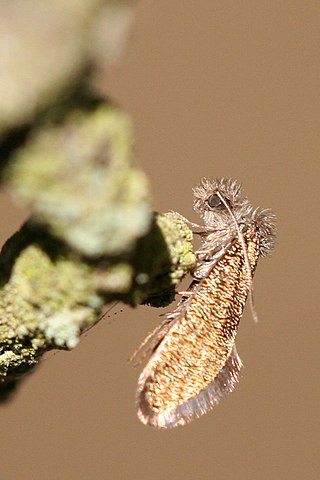
Dyseriocrania subpurpurella is a diurnal moth from the family Eriocraniidae, found in most of Europe. The moth was first named by the English entomologist, Adrian Hardy Haworth in 1828.
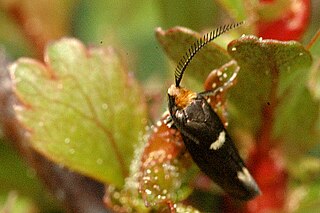
Incurvaria masculella, the feathered leaf-cutter, is a moth of the family Incurvariidae. It is widespread in Europe.
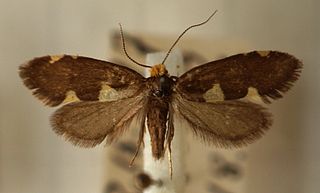
Incurvaria oehlmanniella is a moth of the family Incurvariidae. It is found in Europe and across the Palearctic to eastern Siberia.

Micropterix aureatella is a moth of the family Micropterigidae found in the Palearctic realm, except for North Africa.

The leaf blotch miner moth is a moth of the family Gracillariidae. It is found in Europe, including Turkey.
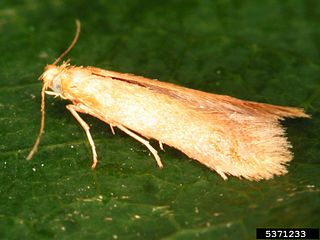
Tischeria ekebladella is a moth of the family Tischeriidae. It is found in most of Europe and the Caucasus.

Tischeria dodonea is a moth of the family Tischeriidae. It is found from Fennoscandia to the Pyrenees, Italy and Romania and from Ireland to Ukraine. There is a disjunct population in eastern Russia.

Ditula angustiorana, the red-barred tortrix, is a moth of the family Tortricidae found in Africa, Asia, Europe and North Africa. Other common names are the fruit-tree tortrix and the vine tortrix. The moth was first described by Adrian Hardy Haworth in 1811.

Phylloporia bistrigella is a moth of the family Incurvariidae. It is found in western, northern and central Europe and north-eastern North America.

Stigmella floslactella is a moth of the family Nepticulidae. It is found in all of Europe, except the Balkan Peninsula and the Mediterranean islands.

Stigmella perpygmaeella is a moth of the family Nepticulidae, found in most of Europe, east to Russia. The larvae mine the leaves of hawthorns.

Incurvaria praelatella is a moth of the family Incurvariidae. It is found in all of Europe, except the Iberian Peninsula.

Stenolechia gemmella is a moth of the family Gelechiidae. It is known from most of Europe

Heliozela resplendella is a moth of the Heliozelidae family. It is found from Fennoscandia and northern Russia to the Pyrenees, Alps and Romania and from Ireland to the Baltic region.

Coptotriche marginea is a moth of the family Tischeriidae, found in most of Europe. It was named by the English botanist, carcinologist and entomologist, Adrian Hardy Haworth in 1828, from a specimen found in England. The larvae mine the leaves of brambles (Rubus) species.

Bryotropha affinis is a moth of the family Gelechiidae. It is found in most of Europe.

Heliozela hammoniella is a moth of the Heliozelidae family. It is found in Ireland, Great Britain, the Netherlands, France, Germany, Austria, the Czech Republic, Poland, Romania, Lithuania, Latvia, Fennoscandia, and Russia.

Teleiodes luculella, the crescent groundling, is a moth of the family Gelechiidae. It is found from Europe to the southern Ural and Transcaucasia. The habitat consists of woodlands, including oak woodlands.

Monochroa tenebrella, the common plain neb, is a moth of the family Gelechiidae. It was described by Jacob Hübner in 1817. It is found in most of Europe. The habitat consists of open grassy areas and heathland.
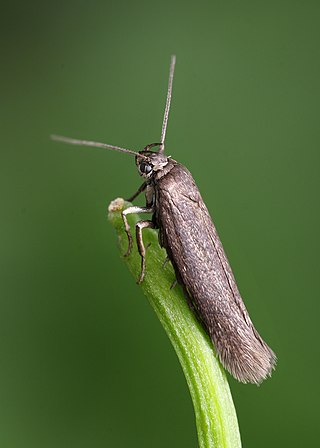
Scythris picaepennis is a moth of the family Scythrididae first described by Adrian Hardy Haworth in 1828. It is found in Europe.



















